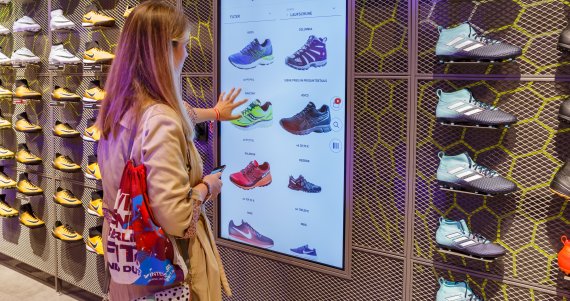
According to a survey, 63 percent of all SMEs do not yet have a suitable digital strategy. Yet the right response to the rapidly changing shopping world, in which one must also hold one's own against online giants like Amazon, is existential for sporting goods retailers. Marcel Altenfelder, Managing Director of Intersport Wohlleben, emphasizes this in the ISPO.com survey: "For a medium-sized company like ours, the issues of manpower and necessary budgets are naturally the bottleneck of digital transformation. We have created the conditions for a high implementation speed, which is essential for survival, by strongly expanding our 'Digital Department'."
ISPO Digitize at the ISPO Munich 2018 in pictures
Of course, this requires money - something that large sports retailer alliances such as Intersport or Sport 2000 have long recognized. "Digitization affects the entire company, regardless of structures and departments. This gives rise to a large number of projects and changes that require new ways of working and thinking. We are challenged both in terms of resources for implementation and in terms of the associated change in corporate culture," says Andreas Rudolf, Managing Director of Sport 2000. The staff must therefore get on board - otherwise there will be no digitization.
"Good change management is of central importance, as the process of digitization can only work if you also take all (or almost all) employees with you on this journey," explains Marcel Altenfelder. In addition to "suitable personnel and high capital requirements, he sees the aging merchandise management system as the biggest brake on growth." So, in the opinion of the retailers, a rethink is also needed in the sports industry in order to be able to deal more flexibly with the ever faster changing trends and the wishes of the customers.
"The lack of standardized interfaces and, in addition, the bringing together of the necessary information requires a very great deal of effort - especially in overcoming the doubters and vested interests that still exist on all sides," says Joachim Kiegele, owner and managing director of Intersport Kiegele in Geisenheim, describing the problems. The necessary conversions for the new age of digitization cost the individual retailers energy and time. "Today, it is almost unthinkable to manage a stationary retail company in a personal union and dedicate yourself to digitization at the same time," says Nicole Kälber, Owner & Managing Director of Intersport Schrey in Pforzheim.
Nevertheless, she believes that investing in the digitization of the company is indispensable for every retailer. Time and money are well spent, however, if you take your staff along for the ride: "Then the funds provided are also worthwhile, because everyone believes in the project and supports it. Not everything is very expensive! Even if people like to put that forward as a reason why they haven't embarked on the project yet." However, he says it is difficult to separate the necessary from the superfluous when it comes to digitization. Kälber: "Which agency has the overview? Where is the common thread? And when you find it, it's only valid for a short time in the fast-changing world at the moment."
This is exactly where ISPO Digitize comes into play - it provides the answers on the topic of digitization for the small retailer as well as large companies in the sports industry. The first ISPO Digitize Summit will therefore also offer "best practice" examples on the topic of digitization at all levels on June 28/29 at the International Congress Center ICM in Munich.
A great tool to check how far you as a company have already progressed with digitization is the Digital Readiness Check. Professor Karl Peter Fischer developed the free online tool together with ISPO and sees a lot of catching up to do in the industry.
This is exactly where ISPO Digitize comes into play – this is where you’ll find the answers for the topic of digitalization, for both small retailers and large companies in the sports industry. The first ISPO Digitize Summit on June 28/29 at the International Congress Center ICM in Munich will therefore offer “best practice” examples on the subject of digitalization at all levels.
A great tool to check how much progress a company has already made in digitalization is the Digital Readiness Check. Professor Karl Peter Fischer developed the free online tool together with ISPO and sees a lot of catching up to do in the industry.
 Sports BusinessSustainable ideas for store design
Sports BusinessSustainable ideas for store design Sports BusinessSports retail in transition: the future playbook for 2025
Sports BusinessSports retail in transition: the future playbook for 2025
- ISPO awards
- Mountain sports
- Bike
- Design
- Retail
- Fitness
- Health
- ISPO Job Market
- ISPO Munich
- ISPO Shanghai
- Running
- Brands
- Sustainability
- Olympia
- OutDoor
- Promotion
- Sports Business
- ISPO Textrends
- Triathlon
- Water sports
- Winter sports
- eSports
- SportsTech
- OutDoor by ISPO
- Heroes
- Transformation
- Sport Fashion
- Urban Culture
- Challenges of a CEO
- Trade fairs
- Sports
- Find the Balance
- Product reviews
- Newsletter Exclusive Area
- Magazine



















